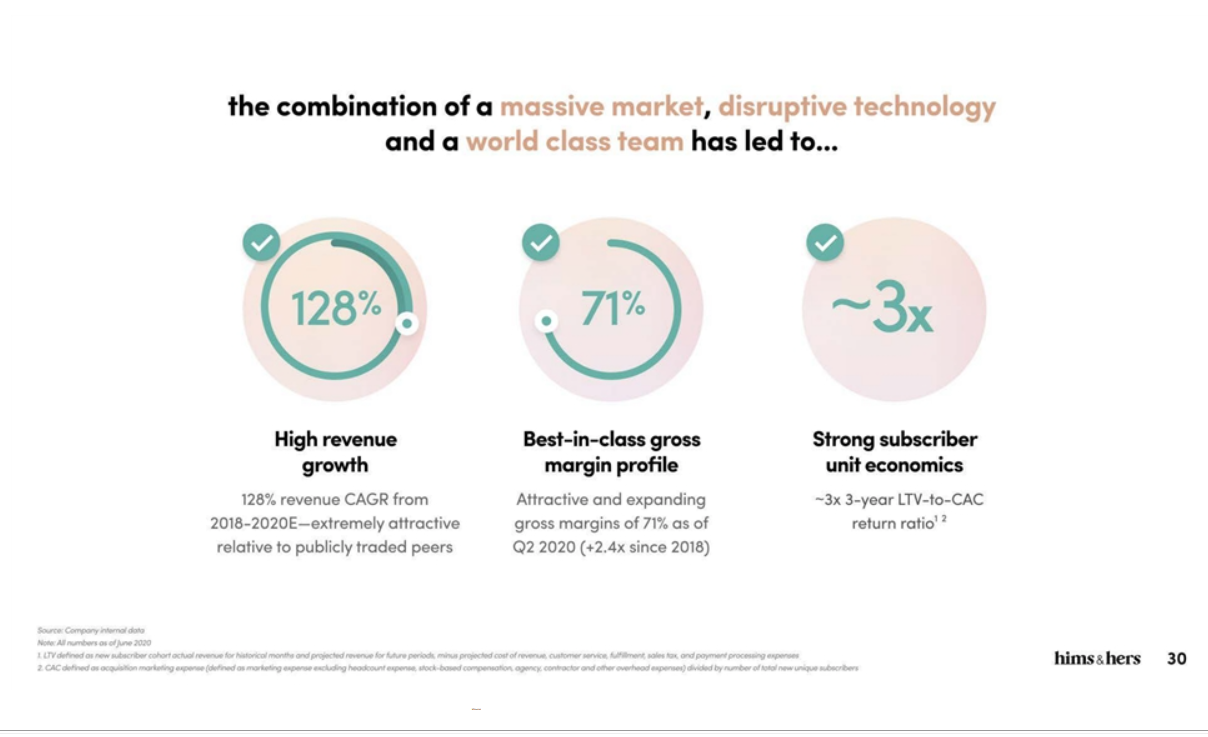A DTC E-prescribing/E-pharmacy business can be extremely profitable. However in order to understand how profitable it can be you should first understand some key concepts and metrics about DTC E-prescribing.
Bullet Point Summary
- CAC
- LTV
- Gross Margins and Cash Flows from LTV/CAC
- Metrics of Hims and Hers
- Forecasting/Projections for Your E-prescribing Companies
- What Is The Cost of Setting It Up?
What is CAC?
CAC stands for Customer Acquisition Cost, which translates to how much money you are spending to get a customer to buy your product. When trying to determine your CAC, you need to add up every direct cost of acquiring that customer. For example, if you are running Google ads and outsourcing the setup of those ads, those costs should be included. If you have someone who is going out and knocking on doors to sell your product, that cost should also be accounted for. For E-prescribing, the CAC is primarily calculated from digital ads and any other costs associated with running them.
What is LTV?
LTV stands for lifetime value. It pretty much means how much a customer is going to spend with your business. It is a calculable total value that the customer brings to the business.
There are a few different ways to arrive at LTV. The most common one is below.
LTV = Average Revenue Per User/customer(ARPU) * Average customer lifespan.
Average customer lifespan in a lot of cases can mean churn. Which is calculated by
(subscribers at the beginning of the month - subscribers end of month)/ customer at the beginning of the month.
In order to tell if an E-prescribing business will be profitable you need to look at and understrand the ratio of LTV/CAC. What this tells you is if the customers you acquire will spend more than what you spend to acquire them.

It is essentially a way to determine how profitable the given demand is for your product. However, factors like how you are selling the product and different marketing methods can skew the ratio.
The best way to visualize how all these things come together in real life is if we take a look at Hims & Hers financials.

The chart on the left shows that for the most part, the LTVs of different cohorts of subscribers are above $200 per subscriber. If we assume that the Revenue per subscriber remained the same throughout the year. We can outline an improvement in that LTV/CAC Ratio
| 2H 2018 | 2019 | Q1 2020 | Q2 2020 |
|---|
| LTV/CAC One Year | 1.3 | 1.3 | 1.5 | 1.9 |
| LTV/CAC Three Year | 2.0 | 2.1 | 2.4 | 3.0 |
By Improving their CAC they were able to improve LTV/CAC to not only make a return on what they spent on acquiring the customer but by Q2 2020 they improved the ratio so much that they are able to make an additional $90-$100 per customer. Then on a three year basis, the LTV of a customer increases to $325. The LTV to CAC ratio becomes extremely attractive.

Through having a good LTV/CAC ratio as well as having good gross margins Him and Hers was able to grow and in 2023

| Q1 2021 | Q2 2021 | Q3 2021 | Q4 2021 | Q1 2022 | Q2 2022 | Q3 2022 | Q4 2022 |
|---|
| New Subscriber ( In thousands) | 140 | 163 | 182 | 179 | 205 | 237 | 269 | 285 |
| Three year LTV acquired by By Quarter | $45,500,000 | $52,975,000 | $59,150,000 | $58,175,000 | $66,625,000 | $77,025,000 | $87,425,000 | $92,625,000 |
Him and Hers was able to acquire an increasing amount of customers with an increased amount of new LTV that was captured.
So what are good rules of thumb when evaluating a business in the DTC e-prescribing space?
- Is the LTV/CAC above 1?
- What is the LTV/CAC Year 1
- What is the LTV/CAC Year 2
- What is the LTV/CAC Year 3
In summary, the ideal CAC Payback should be within 12 months. However, if you are just starting out it is normal for CAC to be high and take a few months to lower. In general as a good assessment of business health, the one-year LTV/CAC ratio should be above 1. As noted in the above hims and hers one year LTV/CAC ratio, From when they started (2017-2018) to 2022 every year they have had a greater than 1 ratio and even increasing it to approach a ratio of 2 year after year.
What do you do if you are planning a stage with no revenue?
- Figure out a basic business plan with:
- A Marketing Budget and plan.
- Customer Acquisition Cost (CAC).
- Financial Projections (see the google sheets template below)
- Organization of who is running what.
- What are you planning on selling the product for? (Price Per Month)
- This helps determine the Lifetime value (LTV) is the total value a customer brings to the business.
- LTV/CAC ratio determines if customers will spend more than what is spent to acquire them.
- Look at ways to improve CAC. The correct LTV/CAC ratio will lead to profitability.
- A good LTV/CAC ratio and gross margin can lead to business growth.
- Look at this google template to help forecast what your DTC E-prescribing business can look like!
Traditionally, it costs hundreds of thousands of dollars and a lot of time to set up one of these DTC E-prescribing/pharmacy companies. However, with Bask Health, you can get set up completely free! We have prebuilt integrations with doctors licensed in all 50 states and also pharmacy integrations for dispensing and fulfillment in all 50 states. We are fully HIPPA compliant and take care of everything on the back end!
Sign up for our beta test.


